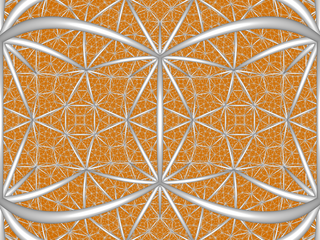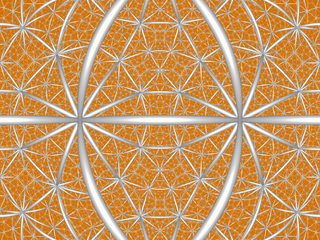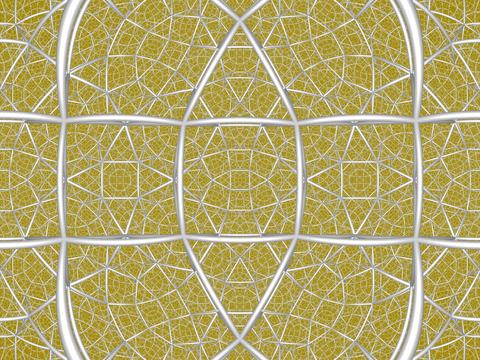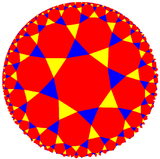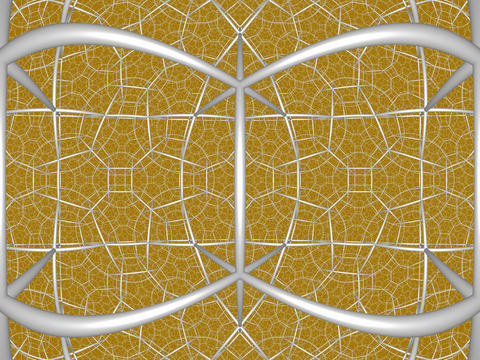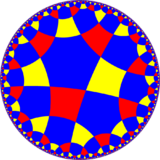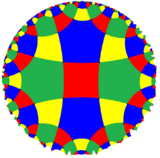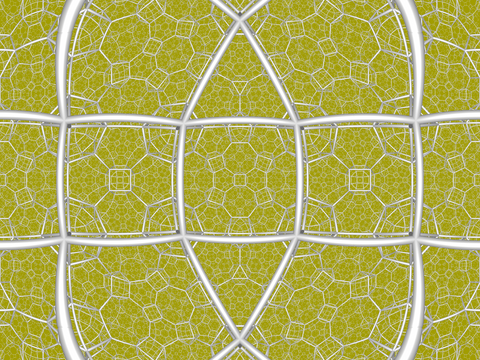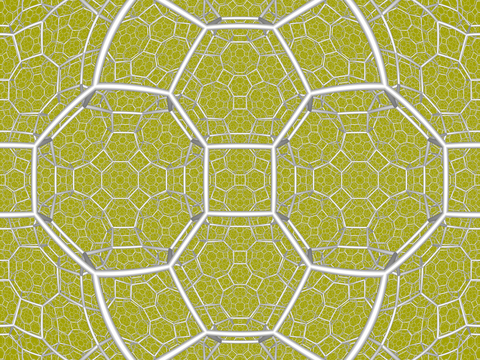Cubic-octahedral honeycomb
| Cube-octahedron honeycomb | |
|---|---|
| Type | Compact uniform honeycomb |
| Schläfli symbol | {(3,4,3,4)} or {(4,3,4,3)} |
| Coxeter diagrams | |
| Cells | {4,3} {3,4} 40px r{4,3} |
| Faces | triangle {3} square {4} |
| Vertex figure |  rhombicuboctahedron |
| Coxeter group | [(4,3)[2]] |
| Properties | Vertex-transitive, edge-transitive |
In the geometry of hyperbolic 3-space, the cubic-octahedral honeycomb is a compact uniform honeycomb, constructed from cube, octahedron, and cuboctahedron cells, in a rhombicuboctahedron vertex figure. It has a single-ring Coxeter diagram, ![]()
![]()
![]()
![]()
![]() , and is named by its two regular cells.
, and is named by its two regular cells.
A geometric honeycomb is a space-filling of polyhedral or higher-dimensional cells, so that there are no gaps. It is an example of the more general mathematical tiling or tessellation in any number of dimensions.
Honeycombs are usually constructed in ordinary Euclidean ("flat") space, like the convex uniform honeycombs. They may also be constructed in non-Euclidean spaces, such as hyperbolic uniform honeycombs. Any finite uniform polytope can be projected to its circumsphere to form a uniform honeycomb in spherical space.
Images
Wide-angle perspective views:
It contains a subgroup H2 tiling, the alternated order-4 hexagonal tiling, ![]()
![]()
![]() , with vertex figure (3.4)4.
, with vertex figure (3.4)4.
Symmetry
A lower symmetry form, index 6, of this honeycomb can be constructed with [(4,3,4,3*)] symmetry, represented by a trigonal trapezohedron fundamental domain, and Coxeter diagram ![]()
![]()
![]()
![]()
![]()
![]()
![]() . This lower symmetry can be extended by restoring one mirror as
. This lower symmetry can be extended by restoring one mirror as ![]()
![]()
![]()
![]()
![]() .
.
Related honeycombs
There are 5 related uniform honeycombs generated within the same family, generated with 2 or more rings of the Coxeter group ![]()
![]()
![]()
![]()
![]() :
: ![]()
![]()
![]()
![]()
![]() ,
, ![]()
![]()
![]()
![]()
![]() ,
, ![]()
![]()
![]()
![]()
![]() ,
, ![]()
![]()
![]()
![]()
![]() ,
, ![]()
![]()
![]()
![]()
![]() .
.
Rectified cubic-octahedral honeycomb
| Rectified cubic-octahedral honeycomb | |
|---|---|
| Type | Compact uniform honeycomb |
| Schläfli symbol | r{(4,3,4,3)} |
| Coxeter diagrams | |
| Cells | r{4,3} rr{3,4} |
| Faces | triangle {3} square {4} |
| Vertex figure |  cuboid |
| Coxeter group | (4,3)[2], |
| Properties | Vertex-transitive, edge-transitive |
The rectified cubic-octahedral honeycomb is a compact uniform honeycomb, constructed from cuboctahedron and rhombicuboctahedron cells, in a cuboid vertex figure. It has a Coxeter diagram ![]()
![]()
![]()
![]()
![]() .
.
- Perspective view from center of rhombicuboctahedron
Cyclotruncated cubic-octahedral honeycomb
| Cyclotruncated cubic-octahedral honeycomb | |
|---|---|
| Type | Compact uniform honeycomb |
| Schläfli symbol | ct{(4,3,4,3)} |
| Coxeter diagrams | |
| Cells | t{4,3} {3,4} |
| Faces | triangle {3} octagon {8} |
| Vertex figure |  square antiprism |
| Coxeter group | (4,3)[2], |
| Properties | Vertex-transitive, edge-transitive |
The cyclotruncated cubic-octahedral honeycomb is a compact uniform honeycomb, constructed from truncated cube and octahedron cells, in a square antiprism vertex figure. It has a Coxeter diagram ![]()
![]()
![]()
![]()
![]() .
.
- Perspective view from center of octahedron
It can be seen as somewhat analogous to the trioctagonal tiling, which has truncated square and triangle facets:
Cyclotruncated octahedral-cubic honeycomb
| Cyclotruncated octahedral-cubic honeycomb | |
|---|---|
| Type | Compact uniform honeycomb |
| Schläfli symbol | ct{(3,4,3,4)} |
| Coxeter diagrams | |
| Cells | {4,3} t{3,4} |
| Faces | square {4} hexagon {6} |
| Vertex figure |  triangular antiprism |
| Coxeter group | (4,3)[2], |
| Properties | Vertex-transitive, edge-transitive |
The cyclotruncated octahedral-cubic honeycomb is a compact uniform honeycomb, constructed from cube and truncated octahedron cells, in a triangular antiprism vertex figure. It has a Coxeter diagram ![]()
![]()
![]()
![]()
![]() .
.
- Perspective view from center of cube
It contains an H2 subgroup tetrahexagonal tiling alternating square and hexagonal faces, with Coxeter diagram ![]()
![]()
![]() or half symmetry
or half symmetry ![]()
![]()
![]() :
:
Symmetry
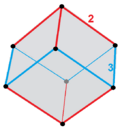 Trigonal trapezohedron |
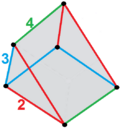 Half domain |
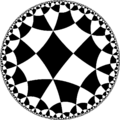 H2 subgroup, rhombic *3232 |
A radial subgroup symmetry, index 6, of this honeycomb can be constructed with [(4,3,4,3*)], ![]()
![]()
![]()
![]() , represented by a trigonal trapezohedron fundamental domain, and Coxeter diagram
, represented by a trigonal trapezohedron fundamental domain, and Coxeter diagram ![]()
![]()
![]()
![]()
![]()
![]()
![]() . This lower symmetry can be extended by restoring one mirror as
. This lower symmetry can be extended by restoring one mirror as ![]()
![]()
![]()
![]()
![]() .
.
Truncated cubic-octahedral honeycomb
| Truncated cubic-octahedral honeycomb | |
|---|---|
| Type | Compact uniform honeycomb |
| Schläfli symbol | t{(4,3,4,3)} |
| Coxeter diagrams | |
| Cells | t{3,4} t{4,3} 40px rr{3,4} 40px tr{4,3} |
| Faces | triangle {3} square {4} hexagon {6} octagon {8} |
| Vertex figure |  rectangular pyramid |
| Coxeter group | [(4,3)[2]] |
| Properties | Vertex-transitive |
The truncated cubic-octahedral honeycomb is a compact uniform honeycomb, constructed from truncated octahedron, truncated cube, rhombicuboctahedron, and truncated cuboctahedron cells, in a rectangular pyramid vertex figure. It has a Coxeter diagram ![]()
![]()
![]()
![]()
![]() .
.
- Perspective view from center of rhombicuboctahedron
Omnitruncated cubic-octahedral honeycomb
| Omnitruncated cubic-octahedral honeycomb | |
|---|---|
| Type | Compact uniform honeycomb |
| Schläfli symbol | tr{(4,3,4,3)} |
| Coxeter diagrams | |
| Cells | tr{3,4} |
| Faces | square {4} hexagon {6} octagon {8} |
| Vertex figure |  Rhombic disphenoid |
| Coxeter group | [2[(4,3)[2]]] or [(2,2)+[(4,3)[2]]], |
| Properties | Vertex-transitive, edge-transitive, cell-transitive |
The omnitruncated cubic-octahedral honeycomb is a compact uniform honeycomb, constructed from truncated cuboctahedron cells, in a rhombic disphenoid vertex figure. It has a Coxeter diagram ![]()
![]()
![]()
![]()
![]() with [2,2]+ (order 4) extended symmetry in its rhombic disphenoid vertex figure.
with [2,2]+ (order 4) extended symmetry in its rhombic disphenoid vertex figure.
- Perspective view from center of truncated cuboctahedron
See also
- Convex uniform honeycombs in hyperbolic space
- List of regular polytopes
References
- Coxeter, Regular Polytopes, 3rd. ed., Dover Publications, 1973. ISBN 0-486-61480-8. (Tables I and II: Regular polytopes and honeycombs, pp. 294–296)
- Coxeter, The Beauty of Geometry: Twelve Essays, Dover Publications, 1999 ISBN 0-486-40919-8 (Chapter 10: Regular honeycombs in hyperbolic space, Summary tables II, III, IV, V, p212-213)
- Jeffrey R. Weeks The Shape of Space, 2nd edition ISBN 0-8247-0709-5 (Chapter 16-17: Geometries on Three-manifolds I, II)
- Norman Johnson Uniform Polytopes, Manuscript
- N.W. Johnson: The Theory of Uniform Polytopes and Honeycombs, Ph.D. Dissertation, University of Toronto, 1966
- N.W. Johnson: Geometries and Transformations, (2018) Chapter 13: Hyperbolic Coxeter groups
 |
